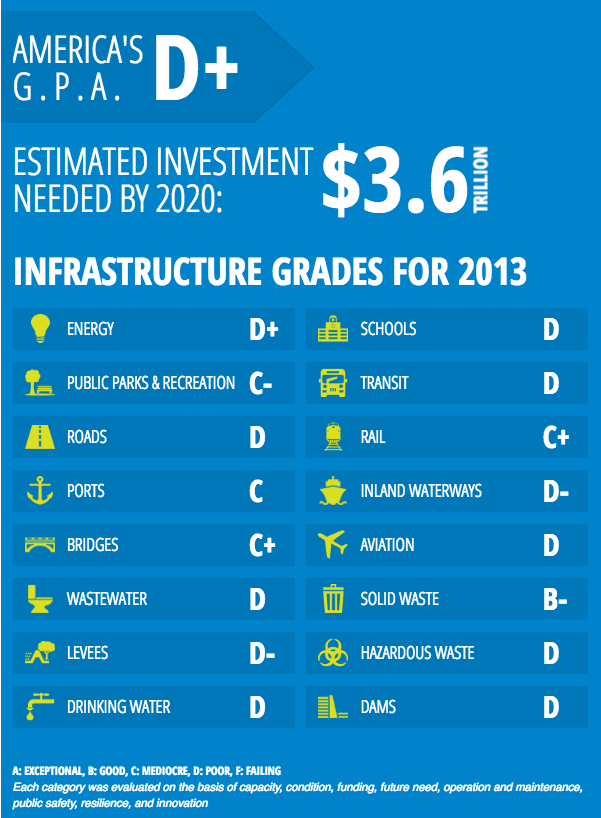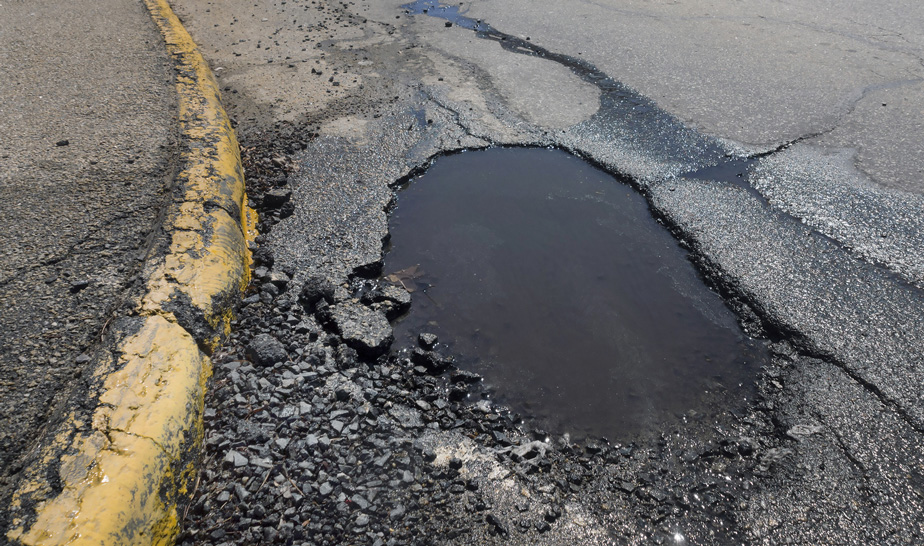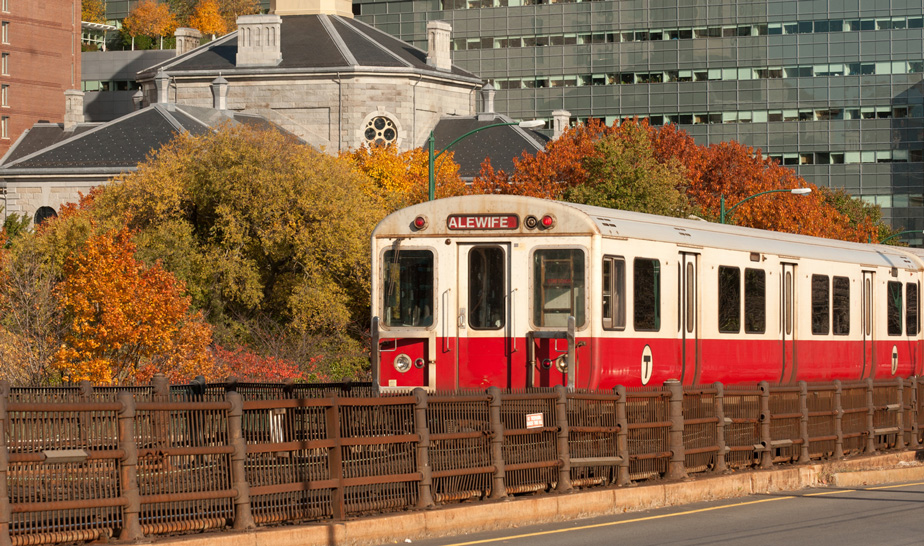Insight
Published and updated
America’s Crumbling Infrastructure Part 1: Transportation
The American Society of Civil Engineers (ASCE) last did a Report Card for America’s Infrastructure in 2013. It looks frighteningly like the report card from my first semester in college.
According to the ASCE Report Card, we need to invest $3.6 trillion by 2020 to modernize our “crumbling infrastructure.” Everything from schools (D) to solid waste (at a B-, the highest grade in the report) needs attention. Otherwise, neglect of the systems that drive commerce, communications, emergency services, transportation, and everything else we rely on to “just be there” starts to cost us.

For example, the ASCE says that 42 percent of U.S. urban highways are congested, costing us $101 billion in wasted time and fuel annually. Aging infrastructure also exposes us to cyber attacks, as was the case at a small Rye Brooke, New York, dam. Iranian computer hackers gained control of the floodgates but did not open them. Some experts believe that the attack on the small dam was practice for an attack on a larger one.
Unfortunately, there is no quick fix for our infrastructure problems. For the first post in this multi-part series, I focused on four transportation infrastructure subsectors (i.e., skies, roads, water and rail) and looked into:
- Why is it “critical”?
- What are the signs of crumbling?
- What’s being done to repair it?
Aviation (ASCE Grade: D)

Why is it “critical”? The U.S. aviation system consists of aircraft, air traffic control systems, and about 19,700 airports, heliports and landing strips. For a sector that features flying machines, there’s a lot happening on the ground.
What are the signs of crumbling? According to the Airports Council International North America (ACI-NA), in 2017 alone U.S. airports will need $15.1 billion in capital development. That money helps accommodate growth in passenger and cargo activity, rehab existing infrastructure, and keep airports in good repair. The International Air Transportation Association (IATA) estimates a 90% increase in passengers using U.S. airports through 2034, and we haven’t constructed a large new airport since Denver International in 1995.
What’s being done to repair it? Senate Bill 2658 is The Federal Aviation Administration (FAA) Reauthorization Act of 2016. It increases funding for the Airport Improvement Program by $400 million to an annual total of $3.75 billion. So we’re only about $11 billion short every year, which is nice.
Highways and Motor Carrier (ASCE Grade: D)

Why is it “critical”? This is the same 4 million miles of roadway, 600,000 bridges and 350 tunnels that we use every day in our cars, buses and trucks. Also included in this category are all licensing systems, traffic management systems and cyber systems for operational management.
What are the signs of crumbling? Aside from the congestion mess mentioned earlier, there are 70,000 bridges that have been deemed structurally deficient, 32 percent of major roads are in poor or mediocre condition, and the Highway Trust Fund depends on an 18 percent gas tax that hasn’t been raised since 1993. Identifying the most dangerous deficiencies too often relies on the good fortune of sausage sandwich picnics. Additionally, three-quarters of infrastructure spending occurs at the state level where cuts dig in yearly (3.8 percent in 2009 and 5.7% in 2010).
What’s being done to repair it? In January 2016, Congress transferred $51.9 billion from the General Fund to the Highway Trust Fund. As of March 2016, the Highway Trust Fund balance was $58.5 billion. State gas tax increases are pending debate in Alabama, Alaska, California, Hawaii, Indiana, Mississippi, Missouri, New Jersey, South Carolina and Delaware.
Maritime Transportation System (ASCE Grades: Ports – C; Inland Waterways – D-)

Why is it “critical”? The 95,000 miles of coastline, 361 ports and 25,000 miles of waterway in the U.S. are vital to the transportation of goods and people.
What are the signs of crumbling? According to The Economist, about 70 percent of America’s imports and 75 percent of its exports go through our ports. Yet just seven American container ports will be able to receive large post-Panama Canal-expansion—“post-Panamax”—ships, which by 2030 are expected to comprise a majority of the world’s container ship capacity. More than half of our inland waterway locks are over 50 years old; the Association of Dam Safety Officials estimates a $21 billion need to repair high-hazard dams; and the National Committee on Levee Safety estimates a $100 billion need to repair aging levees.
What’s being done to repair it? The American Association of Port Authorities says $46 billion will be spent on port terminal facilities in the five-year period ending in 2018. The Association of State Dam Safety Officials has a “Dams Sector Roadmap to Secure Control Systems” to try to beef up digital security. However, that document is from 2010, and the Rye Brook Dam hack took place in 2013. There are lots of holes to plug.
Mass Transit and Passenger Rail (ASCE Grades: Transit – D; Rail – C+)

Why is it “critical”? Passenger trains and mass transit systems provided 10.8 billion passenger trips in 2014.
What are the signs of crumbling? Congress need look no further than the Washington, D.C. Metro’s service interruptions and safety lapses as an example. President Obama said recently, “Look, the D.C. Metro historically has been a great strength of this region, but over time we under-invested in maintenance and repair.” In 2013, the Federal Transit Administration (FTA) identified an $86 billion backlog in deferred repair and replacement of transit assets.
What’s being done to repair it? Passenger rail is actually one of the infrastructure subsectors in the best shape. According to ACSE, Amtrak doubled its ridership from 2000 to 2012, capital investment between 2009 and 2013 exceeded $75 billion, and more tracks, bridges and tunnels are being created to add new capacity
The Tip of the Crumbling Infrastructure Iceberg
If you’ve been keeping up with the math, then you’ll notice that the transportation sectors only account for a few hundred billion of the $3.6 trillion ASCE claims is needed to modernize infrastructure. Other crumbling critical infrastructure in need of funding includes energy, water, communications and manufacturing. I’ll explore those in a future post.